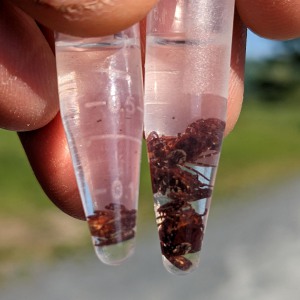Vermont on the lookout for new tick that can cause a meat allergy
| Published: 05-13-2022 9:34 PM |
Volunteers picked through feathers probing for small ticks with a white blaze on their backs at weighing stations during turkey hunting season. Vermont is on the lookout for the lone star tick, a species spreading north.
“Climate change, that’s why we want to monitor these populations,” said Eliza Doncaster, the vector management coordinator at Agency of Agriculture, Food and Markets. “We’re expecting them to make their way here.”
Individual specimens of the lone star tick have been found in both Vermont and New Hampshire. But they are suspected to be hitchhikers from further south that may have arrived with migrating birds, and officials have not confirmed a breeding population to date in either state. However, the Centers for Disease Control and Prevention’s estimated range map includes parts of New York and southern New Hampshire — regions on a similar latitude as Vermont, Doncaster pointed out. And the lone star tick has already established itself in Massachusetts.
Adult females have a distinctive white star on their backs. Nymphs and adult females are the most likely to bite humans, according to the CDC.
The lone star tick’s most unusual attribute is that it can make its hosts allergic to red meat. Its bite sometimes transmits a sugar molecule called alpha-gal that triggers an allergic response to lamb, pork and beef and, in some cases, other animal products. There is no cure, and the reactions range from eczema and a runny nose to difficulty breathing that can prove deadly.
The tick also carries ehrlichiosis, Heartland virus disease, southern tick-associated rash illness (STARI), Bourbon virus disease and tularemia.
In mid-May, the Agency of Agriculture will also be launching its regular tick season surveillance.
Natalie Kwit, the state public health veterinarian, keeps tabs on tick-borne diseases carried by the blacklegged tick, or deer tick. Lyme disease remains the most common, followed by anaplasmosis and babesiosis, a microscopic parasite. Tick-borne diseases are spreading, and not just because of climate change. Lyme disease, for example, is spreading both north and south, she said.
Article continues after...
Yesterday's Most Read Articles
Anaplasmosis is “our fastest emerging” tick-borne disease, Kwit said. In part, that may be because testing has become more common over the last several years, she added.
“With anaplasmosis, it’s a little more common to have severe outcomes (than Lyme disease), especially in people of older age or who have comorbidities that weaken the immune system,” she said.
A vaccine for Lyme disease may be only a few years away, but Kwit has not heard of vaccines in the works for other tick-borne diseases.
Claire Potter is a Report for America corps member. She can be reached at cpotter@vnews.com or 603-727-3242.

 JAG Productions announces closure, citing ‘crisis facing the arts’
JAG Productions announces closure, citing ‘crisis facing the arts’ How a hurricane and a cardinal launched a UVM professor on a new career path
How a hurricane and a cardinal launched a UVM professor on a new career path Out & About: Vermont Center for Ecostudies continues Backyard Tick Project
Out & About: Vermont Center for Ecostudies continues Backyard Tick Project Art Notes: After losing primary venues, JAG Productions persists
Art Notes: After losing primary venues, JAG Productions persists 
